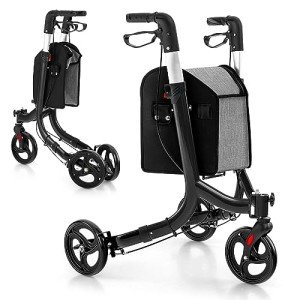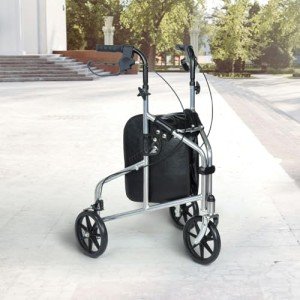Watch Out: How Rollator Walker Is Taking Over And What You Can Do About It
The Comprehensive Guide to Rollator Walkers
As the population ages, the demand for mobility aids like rollator walkers has actually surged. These walkers supply stability, assistance, and flexibility of motion for people handling mobility issues, be they short-lived or chronic. Understanding the kinds of rollator walkers available, their benefits, functions, and how to pick the right one can substantially boost the quality of life for both the user and their caregivers.

What is a Rollator Walker?
A rollator walker is a mobility aid designed to help individuals keep their independence while walking. It includes a frame with 4 wheels, hand brakes, and a seat, making it appropriate for users requiring extra assistance without the complete constraints of conventional walkers.

Secret Features of Rollator Walkers
Rollator walkers come equipped with different features created to enhance user experience. Here are a few of the most common functions:
- Four-Wheel Design: The most appreciable feature is its four wheels, which permit smoother shifts over numerous surfaces.
- Cushioned Seat: Many rollators featured an integrated seat, providing a resting point for users who may tire quickly.
- Hand Brakes: Most designs have hand brakes that permit users to secure the walker in location when sitting or browsing unequal surface areas.
- Storage Options: Many rollators consist of a basket or storage pouch for individual items, such as water bottles or little bags.
- Adjustable Height: Users can personalize the height of the deals with for ideal comfort and posture.
Benefits of Using a Rollator Walker
Rollator walkers offer various benefits. They can considerably enhance mobility and safety for users. Here are some crucial benefits:
- Enhanced Stability: With 4 wheels and a sturdy frame, rollators provide remarkable stability compared to standard walkers.
- Practical Seating: The integrated seat allows users to rest whenever required, promoting longer getaways without fatigue.
- Increased Confidence: The added support can assist users feel more safe and secure throughout strolls, which can cause longer distances took a trip.
- Improved Posture: With adjustable heights, users can preserve a more natural posture while walking, which can minimize pain.
- Self-reliance: Rollators allow lots of individuals to regain or maintain independence in their daily activities.
Kinds Of Rollator Walkers
Rollator walkers come in various styles and variations to meet individual needs. Here are a few typical types:
| Type | Description |
|---|---|
| Standard Rollator | Basic four-wheeled design developed for indoor and outdoor use. |
| Junior Rollator | A smaller variation customized for shorter people or kids. |
| Durable Rollator | Developed to accommodate larger body weights and supply extra stability. |
| Three-Wheel Rollator | Compact style suitable for browsing tight areas. |
| Rollator with Seat | Functions an integrated seat for resting throughout use. |
| Rollator with Storage | Features removable baskets or pouches for simple transport of personal products. |
Picking the Right Rollator Walker
Picking the ideal rollator walker involves thinking about user requirements, choices, and physical requirements. Here are some elements to think about:
- User Height and Weight: Ensure the walker can support the individual’s weight and can be changed to their height.
- Surface: Consider where the walker will primarily be utilized. Removable wheels can assist move efficiently over rough terrains.
- Storage Needs: Determine if additional storage area is necessary for the user’s everyday requirements.
- Mobility: If regular transportation is needed, lightweight tri walker rollator: easy mobility & Comfort models or those that fold for simple storage must be chosen.
- Budget: Prices can differ substantially; ensure the chosen walker supplies worth without compromising quality.
Maintenance of Rollator Walkers
Appropriate maintenance can enhance the life expectancy of a rollator walker. Here are some tips for keeping it in excellent condition:
- Regular Check-ups: Periodically check brakes and wheels for wear and tear.
- Clean the Walker: Use a mild detergent and fabric to wipe down surfaces and get rid of dirt.
- Examine for Loose Parts: Tighten any screws or bolts that might become loose with regular use.
- Change Parts as Needed: Wheels, hand grips, and brakes can break and may require replacement for optimal efficiency.
Frequently Asked Questions About Rollator Walkers
Q1: What is the typical weight limit for a rollator walker?A: Most basic rollator walkers support weights in between 250 to 300 pounds, while durable designs can accommodate as much as 500 pounds. Q2: Can rollator walkers be used outdoors?A: Yes, numerous rollatorsare developed for outdoor use. Those with
larger wheels and robust frames are particularly matched for irregular surface areas. Q3: Do rollator walkers include warranties?A: Many producers provide warranties ranging from 1
to 5 years on the frame and parts, ensuring sturdiness and user fulfillment. Q4: How do I properly adjust a rollator walker?A: Adjust the handles to a height that allows the user to stand upright with
elbows somewhat bent when holding the handles. Q5: Can
I use a rollator walker for rehabilitation?A: Yes, rollators are frequently used in rehabilitation settings to enhance walking self-confidence and mobility
after injuries or surgical treatments. Rollator walkers
are important tools that provide improved mobility and independence for lots of people. By comprehending the types, benefits, and proper use of rollator
walkers, users can make educated decisions that best fit their way of life and needs. Whether recovering from an injury or handling a long-lasting condition, a rollator walker can make a significant difference in the lifestyle, allowing people to restore their liberty and confidence while moving about the world.

